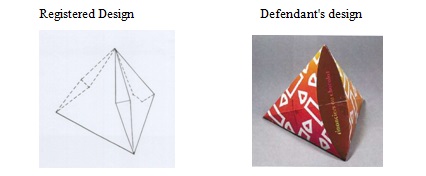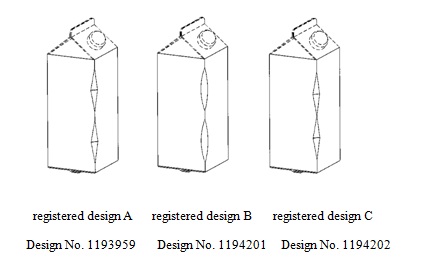Case No. Heisei 27 (ne) 10077
Decision date: January 27, 2016
Court: IP High Court
(http://www.courts.go.jp/app/files/hanrei_jp/632/085632_hanrei.pdf)
The plaintiff, who holds a design right for a partial design of an article “Packaging Box” (Design Registration No. 1440898; the “Design Right”), alleged against the defendant that the defendant infringes the Design Right by manufacturing and selling its packaging box. The Tokyo district court dismissed the plaintiff’s complaint because the registered design and the defendant’s design were not similar to each other (Case No. Heisei 26 (wa) 12985; http://www.courts.go.jp/app/files/hanrei_jp/152/085152_hanrei.pdf). The plaintiff then appealed to the IP High court. Conclusively, the IP High court also dismissed the appeal.

(cited from http://www.courts.go.jp/app/files/hanrei_jp/632/085632_hanrei.pdf)
There are differences between the registered design and the defendant’s design in the concrete shape of the accent panel which is the gist of the registered design (The accent panel is a concave surface formed along one of three edge lines extending from an upper point at a top of the body to lower points forming a bottom surface.). In this connection, the nearly rhombic shape formed by straight lines generally provides sharp and solid impression in the registered design, while the nearly spindle shape formed by curved lines generally provides rounded and soft impression in the defendant’s design.
Regarding the differences of the concrete shape of the vertically central portions of the accent panels, the accent panel in the registered design is significant in that the bottom sides of the isosceles triangles are intended to form a folded configuration and has an ornamental function in a polyhedron in appearance, while in the accent panel in the defendant’s design, the vertically central portion shows the horizontal folding line across the accent panel, but no folded configuration can be seen. Thus, the esthetic feelings obtained from these accent panels are different.
Regarding the ratio of the vertical length with respect to the central width in the accent panel, the ratio in the registered design is 8:1 so that a narrow and sharp feeling is obtained, while the ratio in the defendant’s design is 4:1 so that a fleshy and gentle feeling is obtained. Thus, the aesthetic feeling in the registered and defendant’s designs are different in this point.
A position and so on of the partial design with respect to the entire article should be considered. In the registered design, the opening (shown in the right-hand side surface) of the packaging box is not arranged in the surface of the accent panel so that the accent panel has no function as the opening, while in the defendant’s design, the accent panel is arranged as the opening and has the function of the opening. Considering the function of the packaging box, since it is necessary for removing contents contained in the box, the difference in the positions of the openings is a great difference for a supplier and a consumer. Thus, the aesthetic feelings of the registered design and the defendant’s design are not common in this point.
As a result, the registered design and the defendant’s design provide different aesthetic feelings to a viewer as a whole, and the common points are not considered to overcome the different aesthetic feelings.
Thus, the defendant’s design is not similar to the registered design.
The plaintiff asserted that the shapes of the accent panels of the registered design and the defendant’s design are publicly known as shown in registered designs A-C below, in which different accent panels are arranged in a nearly rectangular parallelepiped, and it should be considered that these registered designs A-C are similar to each other (These designs are registered as a principal and related designs).

The court held that in these registered designs A-C, along one long side of a rectangular parallelepiped of a packaging container, two nearly rhombic concave surfaces (registered designs A and C) or two nearly spindle concave surfaces (registered design B) are formed except for opposite end portions of the long side. Since these designs are rectangular parallelepipeds, the numbers of surfaces and sides thereof are different from those in a triangle pyramid so that a degree of attention to one side in the rectangular parallelepiped is smaller than that to one side in the triangle pyramid. Further, these registered designs A-C are different from the present registered design and the defendant’s design in which one accent panel is formed entirely along on an edge line of the packaging box so as to give a strong impression as surfaces of a polyhedron. Thus, the registered designs A-C should not be considered.